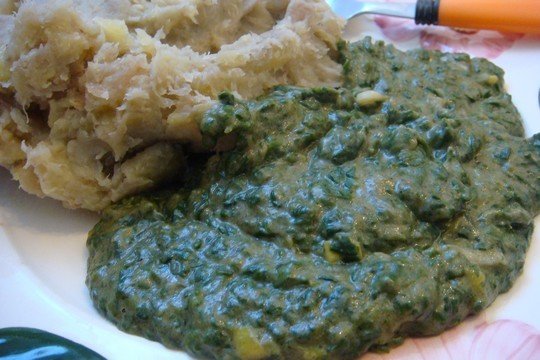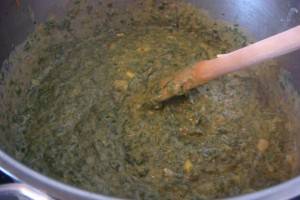
- Cuisine: East African
- Cuisine: East African
- Cuisine: East African
This BASIC Spinach in groundnut/peanut sauce recipe shows how to prepare spinach or other similar vegetables in groundnut (peanut) sauce. Different vegetables in groundnut sauce are widely eaten in many, not only African countries and Uganda is no exception. This is not only good for vegetarians.
Ingredients
- 500 grams spinach ((fresh or frozen))
- 300 grams Groundnut/peanut butter ((FINELY )
- water ((or beef, chicken or vegetable stock))
- salt to taste
- pepper to taste
- curry ( or other spices of choice))
- For: 4 servings
- Preparation: 15 min
- Cooking: 30 min
- Ready in: 45 min
Instructions
- Most folks would use fresh, leafy spinach, which I did not have at this time (see accompanying video), but the results are not that different. ...
- In case of fresh spinach, bring it to the boil in some hot water and cook for a few minutes. Same with frozen.
- Add the groundnut paste and stir so it gets well mixed, on medium heat. Make sure it does not get scotched at the bottom of the pan. You will need to repeatedly stir.

- Add salt, pepper and any other spices of choice. The sauce should be quite thick. Should it get too thick, add some water.
- Unless the groundnut/peanut paste was made from "unroasted" nuts, about 15 - 20 minutes of cooking should do. Logically, unroasted paste or not finely ground nuts need more time. The key thing is, the vegetables and the groundnut sauce getting cooked.
Notes
Unroasted groundnut paste/powder gives the sauce a different taste and takes longer to cook. If “peanut butter” from a supermarket is used, logically, it should not be the sweetened.
Some folks would cook this differently, by frying some onions with a tomato or 2, add the spinach before adding the groundnut paste, and probably use curry powder. The taste can be changed or enriched by using chicken, beef or vegetable stock (such as that made with “Maggi” cubes) instead of mere water.
In many parts of Uganda, such sauce is served with “matooke”, which is bananas cooked the traditional way, by steaming them and later mashing them while wrapped in banana leaves. This gives then a special aroma and taste, which you don’t get by merely steaming them in a pan, which can however also do. You can also eat this with steamed potatoes, sweet potatoes, cassava (maniok, tapioca, yucca), ugali (posho, nshiima, pap), etc.
In the first picture, this sauce was served with steamed, mashed bananas BUT not the type normally cooked in many parts of Africa. These were very slightly ripe “sweet bananas” [i.e. almost completely green], from a super market, such as “chiquita” [ see examples of the “ripe type” => Google images results for “chiquita” ]. I was very skeptical when I was told they are not a bad substitute to the “real” but considerably more expensive type imported from Uganda, but after peeling and steaming them, which takes a few minutes and mashing them, the taste was acceptable. So if you are in the “diaspora” and have no access to “matoke”, and you really miss the home stuff, this could help a bit, though as you will note, it’s not the “real” thing.
In West Africa, in countries like Guinea, they’d probably add lots of other stuff to the sauce, like chunks of fish or chicken or cooked beef and lots of pepper or ALL of that!
Since spinach & lots of other similar vegetables do not take long to cook, they’d be added after the chicken/beef is soft enough. This Wikipedia article http://en.wikipedia.org/wiki/Matoke shows some pictures of “matoke”. A google image search for “matoke” delivers lots of pictures showing not only the raw bananas, but lots of pictures showing them in cooked and other forms => Google images search reasults for “matoke”.
A related recipe on this site: Vita’s Spinach and Chicken in Groundnut Sauce. Share your experience or version in forum or comment on this! (Requires being registered.)
